Creating a mini pond with a waterfall—it’s like hosting a spa day for my garden.
First off, I had to choose the perfect sunlit spot. Cue the overwhelming anxiety: “What if it rains too much?”
I went with the Aquascape liner—let’s hope it actually holds water and doesn’t turn into a kiddie pool. I installed a pump that pushes between 500-1500 GPH. Honestly, I just picked a number that sounded fancy.
To make it extra special, I added some native aquatic plants. Who knew they could blossom so beautifully? It’s truly a work in progress, filled with joyful chaos.
As I leaned back, enjoying my water feature, I couldn’t help but chuckle at the misadventures along the way.
My Garden Design Journey: Learning from Mistakes
The first time I decided to go all out on my garden design, I ambitiously planted a dozen different flowers without much thought. Spoiler alert: they clashed like an ’80s rock band.
I learned the hard way about color schemes and how important it is to balance vibrant hues with earthy tones. After my chaos, I transformed that garden into a harmonious space with a soothing color palette.
Now, as I stroll through my redesigned paradise, I find joy in the simple beauty that stems from thoughtful planning. All those lessons? Priceless!
Quick Takeaways
- Assess the site for sunlight, drainage, and viewing spots before planning the mini pond and waterfall layout.
- Choose high-quality materials, including durable liners, natural stones, and aquatic plants for aesthetic and ecological harmony.
- Install the pond liner securely, ensuring proper waterproofing and ample overhang for durability.
- Select an effective pump and plumbing setup for optimal water circulation, considering flow rate and pipe diameter.
- Incorporate diverse aquatic plants and natural elements to enhance biodiversity and maintain ecological balance in the pond.
Planning Your Mini Pond Layout
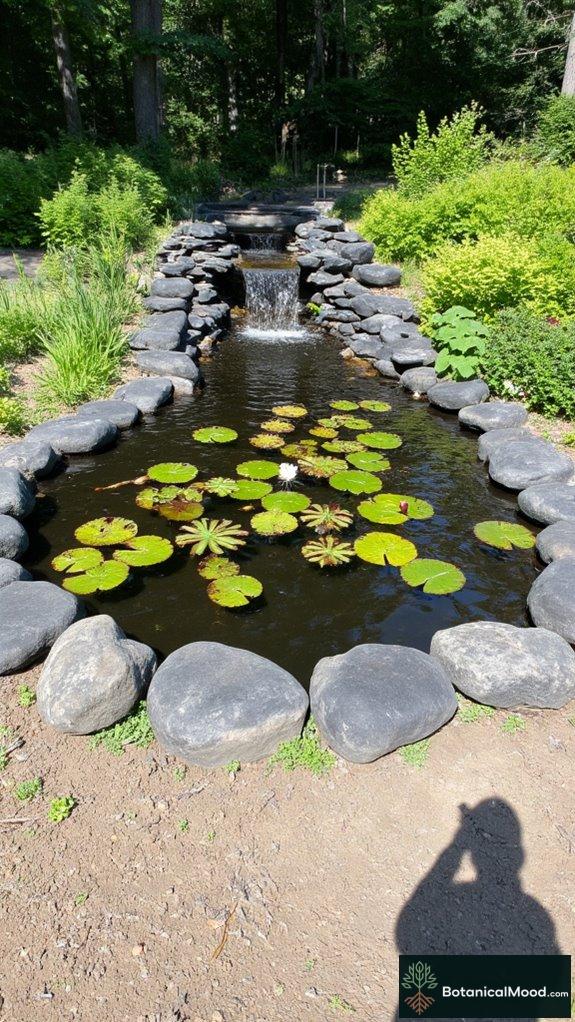
When I’m planning my mini pond layout, I find it helpful to visualize my space in unique dimensions, as even a small area can become an alluring oasis with a thoughtful design.
Site selection is vital; I assess sunlight, drainage, and proximity to favorite viewing spots.
Next, I create a layout sketch, highlighting key features like rocks, waterfalls, and aquatic plants.
Choosing the right materials, from durable liners to decorative stones, enhances stability and aesthetics.
By emphasizing harmony between water and greenery, I guarantee an enchanting retreat.
Botanical Mood reflects my passion for exquisite garden design, showcasing the transformative power of tiny water features.
Installing the Liner and Waterproofing
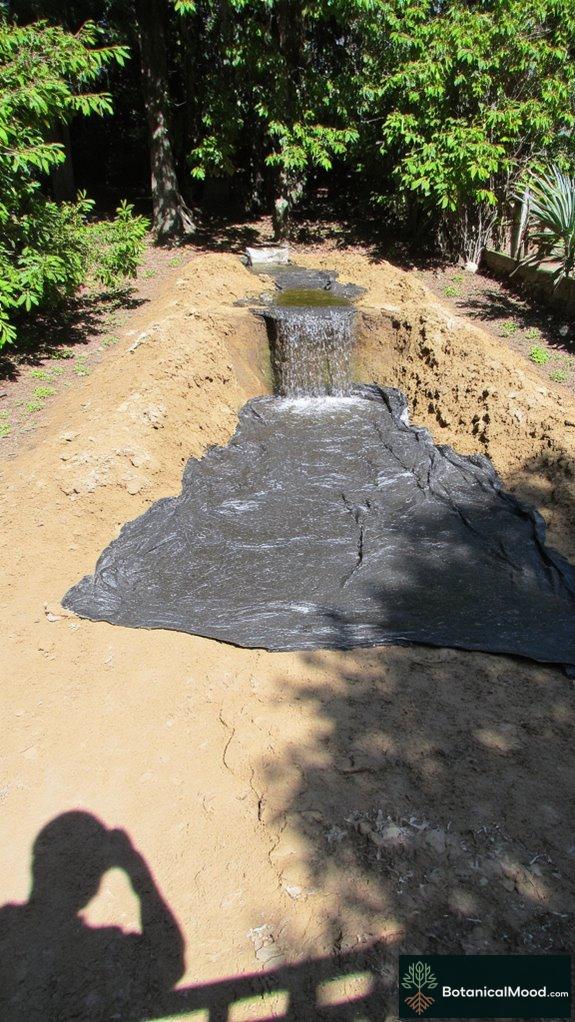
As I immerse myself in installing the liner and waterproofing my mini pond, I realize the importance of precision; this step is essential for ensuring that my carefully designed oasis remains vibrant and water-filled.
To achieve flawless liner’s installation and effective waterproofing techniques, I meticulously follow these steps:
Meticulous steps for flawless liner installation and effective waterproofing are essential to maintain a vibrant pond oasis.
- Select a high-quality pond liner that matches the dimensions of my pond, ensuring proper fit.
- Clear the pond bed of sharp stones and debris to prevent punctures.
- Lay the liner, allowing ample overhang to secure it in place.
- Apply waterproofing solutions as needed to seal edges and enhance durability.
Setting Up Pump and Plumbing

Now that the liner is securely in place and waterproofed, my focus shifts to the heart of the mini pond—the pump and plumbing system. Selecting the right pump is vital for an efficient water flow, and I often recommend brands like Aquascape or Little Giant for their reliability.
Here are some plumbing tips to take into account:
| Plumbing Component | Recommended Size |
|---|---|
| PVC Pipe Diameter | 1.5 to 2 inches |
| Hose Length | Minimum 10 feet |
| Pump Flow Rate | 500-1500 GPH |
| Fittings Type | Barbed or Slip-on |
| Check Valve Size | Same as pump outlet |
Incorporating these elements guarantees that my mini pond operates smoothly and effectively.
Building the Waterfall Structure

Building an aesthetically pleasing waterfall structure requires careful planning and a keen eye for design, particularly since waterfalls can serve as both a focal point and an auditory experience within your mini pond.
Creating a captivating waterfall demands thoughtful design, enhancing visual appeal and soothing sounds within your tranquil pond.
To achieve this, consider these essential elements:
- Waterfall materials: Choose durable options like natural stone or concrete for strength and aesthetics.
- Base foundation: Create a sturdy base to support your design and prevent erosion.
- Layering techniques: Use varying heights and angles to add depth and interest.
- Water flow: Guarantee smooth, harmonious water movement for a serene ambiance.
These elements guarantee an enchanting cascade, elevating the entire space.
Enhancing With Plants and Natural Elements

Creating a balanced and inviting mini pond isn’t just about the water features; it’s also about harmonizing the surrounding plant life and natural elements that can significantly enhance the aesthetic appeal and ecological health of your space. Integrating aquatic plants like water lilies, cattails, and pickerel rush not only enriches visual depth but also provides habitat for wildlife. Pair these with rocks, driftwood, or pebbles to accentuate the natural aesthetics. Mini ponds can contribute to biodiversity by attracting various species of beneficial insects and birds. Here’s a quick reference guide to help you choose ideal plants and elements:
| Plant Type | Function | Natural Element |
|---|---|---|
| Water Lilies | Shade & beauty | Smooth river rocks |
| Cattails | Wildlife habitat | Driftwood |
| Pickerel Rush | Erosion control | Decorative pebbles |
| Water Hyacinth | Water filtration | Boulders |
| Hornwort | Oxygenation | Lush green foliage |
Sample Designs for Mini Ponds

When imagining the perfect mini pond, isn’t it fascinating to contemplate how various designs can profoundly influence the ambiance of a garden?
Through careful selection of creative styles and functional features, each design serves a specific purpose.
- Classic Serene Garden Pond: Layered rocks and soothing aquatic plants like water lilies for tranquility. This design not only promotes relaxation but also attracts wildlife like birds and butterflies, enhancing the natural beauty of the space. Additionally, a well-placed pond can serve as a natural focal point in the landscape design, drawing the eye and enhancing overall aesthetics.
- Modern Minimalist Waterfall: Clean lines with durable materials, ideal for compact spaces.
- Rustic Stone Waterfall Design: Natural stones and multiple spillways mimic mountain streams.
- Pondless Waterfall Features: Aesthetic harmony without visible ponds, minimizing maintenance, perfect for steep terrain.
Each choice enhances your garden masterfully!
Pond Placement and Size Considerations
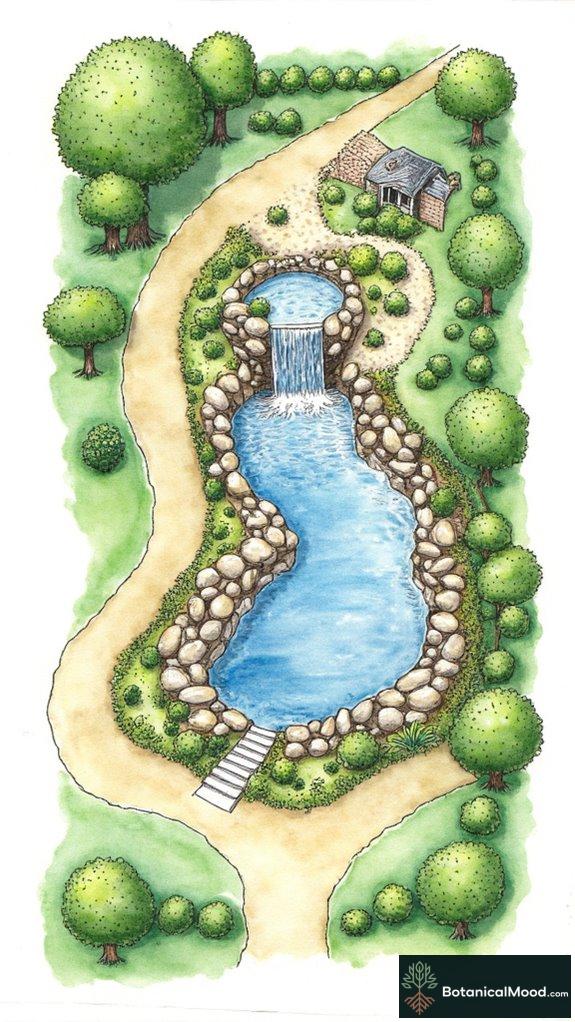
While establishing a mini pond in your garden, it’s essential to carefully consider both its placement and size, as these factors greatly influence not only the aesthetic appeal but also the ecosystem’s health.
Opt for a location receiving partial sunlight for 4-6 hours daily, enhancing plant growth while preventing overheating.
Ensure the pond’s depth accommodates a wildlife habitat, featuring shallow zones for emergent plants and refuge areas for aquatic species.
Aim for a minimum surface area of 4-5 square meters to support diverse wildlife.
Always consider accessibility for maintenance and proximity to a reliable water source for topping up.
Water Feature Integration Tips
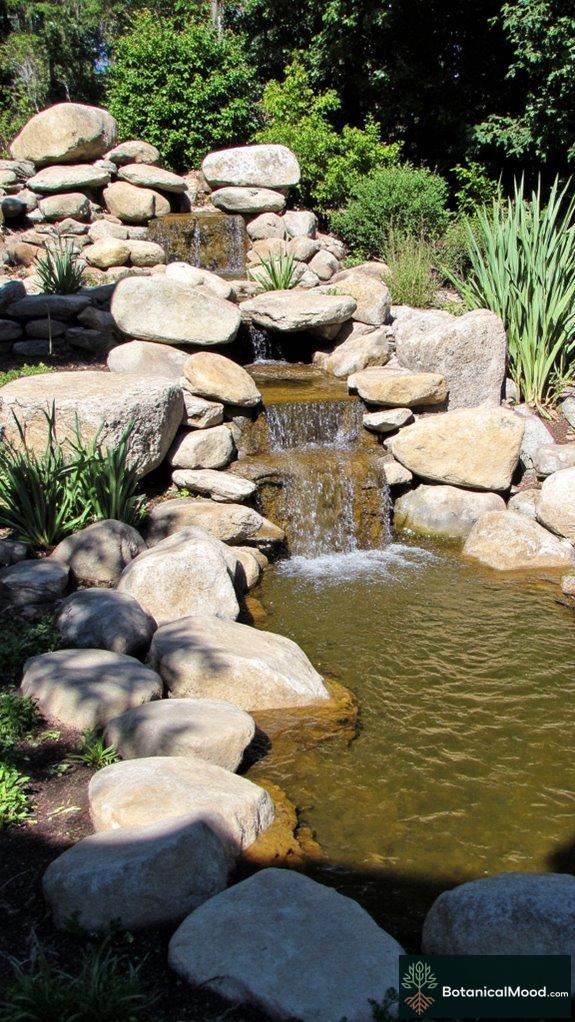
Integrating a water feature like a waterfall into your mini pond can transform the space into a dynamic focal point, enhancing both its beauty and ecological function.
Here are some powerful integration tips to elevate water feature aesthetics:
- Arrange rocks with varying sizes to create cascading tiers, ensuring dynamic water movement.
- Secure your structure with waterfall foam for durability and proper flow.
- Position the pump for ideal flow, facilitating efficient pump maintenance.
- Use natural stones to harmonize with the landscaping, fostering a seamless design.
In addition, incorporating natural water filtration elements can further improve water quality and support a thriving ecosystem.
Decoration With Small Garden Pond Designs

Creating a striking mini pond in your garden can enhance its aesthetic appeal and provide a serene escape from the hustle of everyday life.
I recommend positioning your pond near focal points, ensuring accessibility and wildlife entry, while surrounding it with decorative stones and colorful flowering plants.
Your plant choices should include native aquatic species like water lilies and irises for natural filtration and visual interest.
Incorporate lighting and sculptures to elevate ambiance, and consider using pebbles along the edges to seamlessly blend the water feature with its environment.
This creates a harmonious sanctum that invites tranquility and connection with nature.
Meet the Garden Visionary
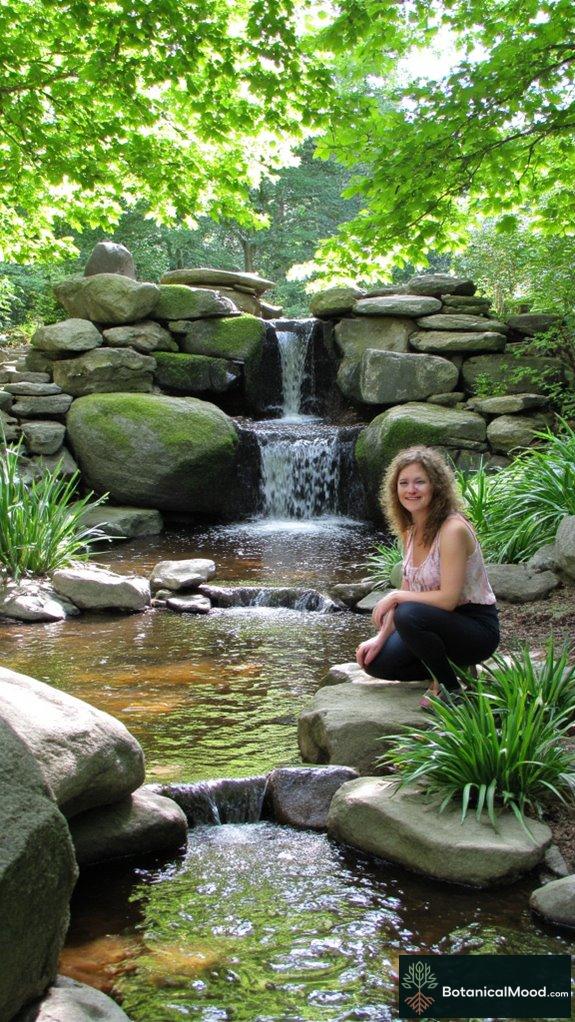
Owner Sarah Thompson hails from Asheville, North Carolina. Drawn by her childhood memories of serene ponds and vibrant gardens, she’s always envisioned creating a tranquil oasis that reflects her love for nature.
To bring her vision to life, Thompson commenced on an extensive garden design process, collaborating with site planners and horticulturists. She meticulously planned the layout, integrating elements like mini ponds and cascading waterfalls that harmonize with the surrounding flora, all while considering both aesthetics and ecology.
Using tools from brands like Fiskars for precision cutting and Aquascape accessories for pond filtration, Thompson crafted her dream garden.
She consulted local horticulturists for plant selections, incorporating native species to support local wildlife and promote biodiversity in her environment.
Renowned Landscape Designers

Designing serene vistas that feature enthralling water elements requires the expertise of renowned scenery designers who specialize in creating harmonized environments.
To achieve breathtaking results, I often draw inspiration from water feature trends and elevated design principles:
- Integrating natural materials like boulders and stones for authenticity.
- Prioritizing safety through pondless waterfalls for family-friendly sceneries.
- Engaging users with interactive backyard pond and waterfall designs.
- Emphasizing low-maintenance ecosystems that foster tranquility and sustainability.
Share Your Own Garden
Building a mini pond with a waterfall in my garden was a rewarding experience. I carefully selected plants and natural materials to create a peaceful setting. Watching wildlife thrive and relaxing by the water has truly transformed my outdoor space into a beautiful retreat.
I’d love to hear about your experiences with mini ponds! What challenges did you face, and what did you enjoy most?
Feel free to share pictures of your own garden designs! I’m excited to see how you created your serene oasis.
References
- https://www.reflectionswatergardens.com/blogs/small-koi-pond-with-waterfall-guide/
- https://premierpond.com/creating-a-waterfall-backyard-pond/
- https://www.instructables.com/Backyard-Pond-and-Waterfall-No-Experience-Necessar/
- https://www.thepondguy.com/learning-center/small-pond-waterfall-ideas/
- https://www.youtube.com/watch?v=lKc4taK5oRI
- https://dundeedig.com/backyard-ideas/small-pond-with-waterfall-ideas/
- https://www.youtube.com/watch?v=sZVKHkiktSs
- https://www.youtube.com/watch?v=ZcsKW7xUe8g
- https://www.pinterest.com/dcraig6374/ponds-waterfalls/
- https://www.pinterest.com/shrubsforsale/ponds-waterfalls/
